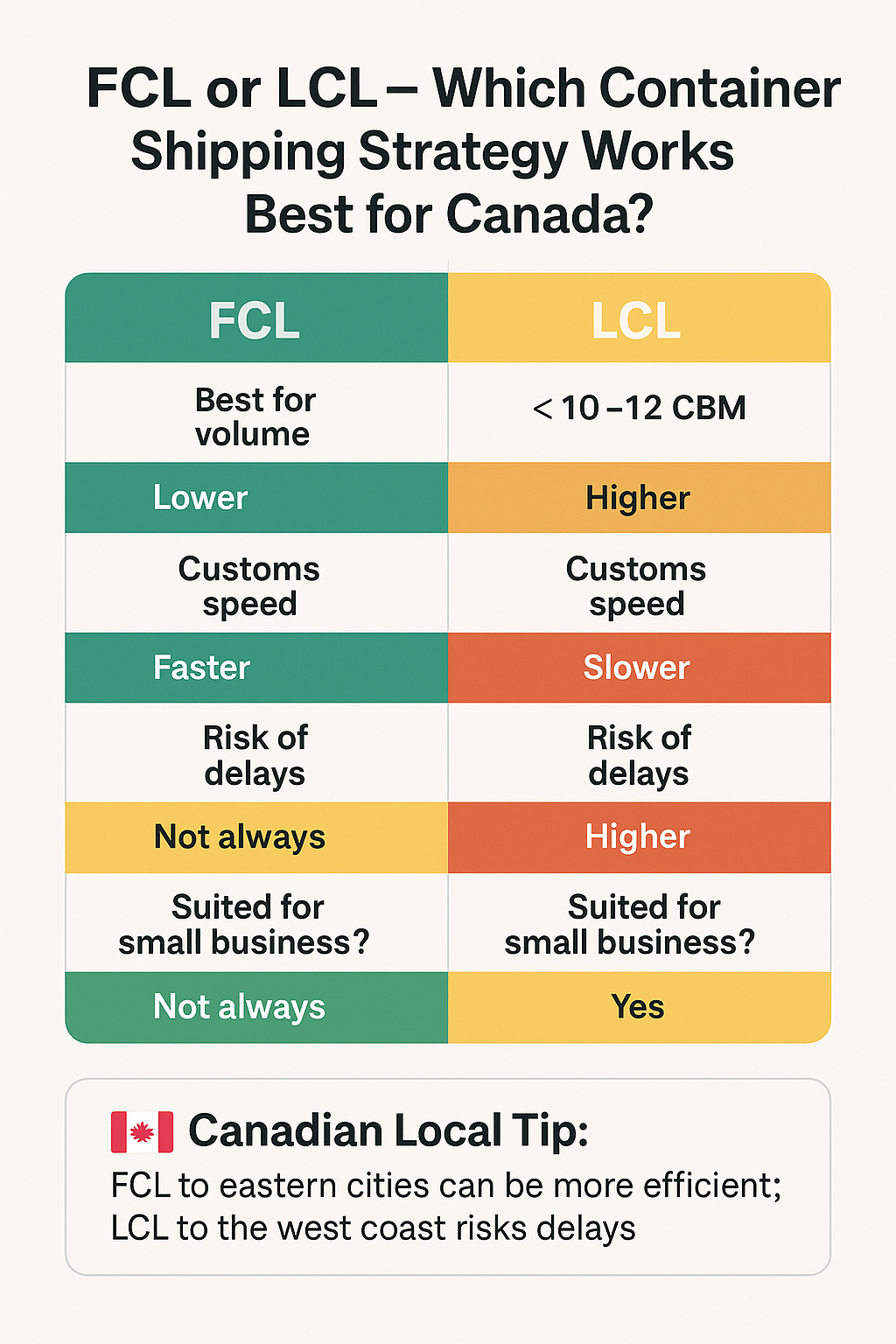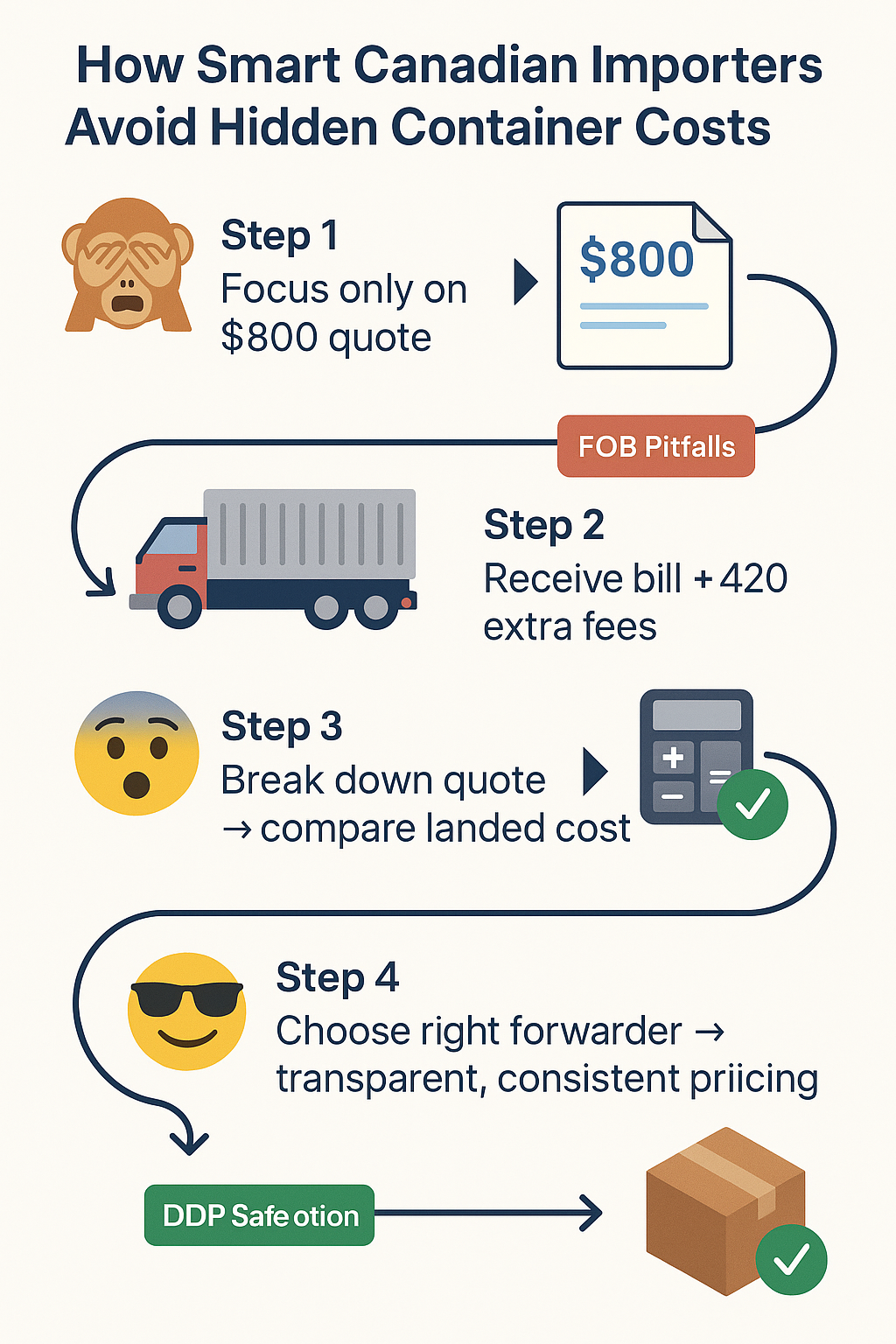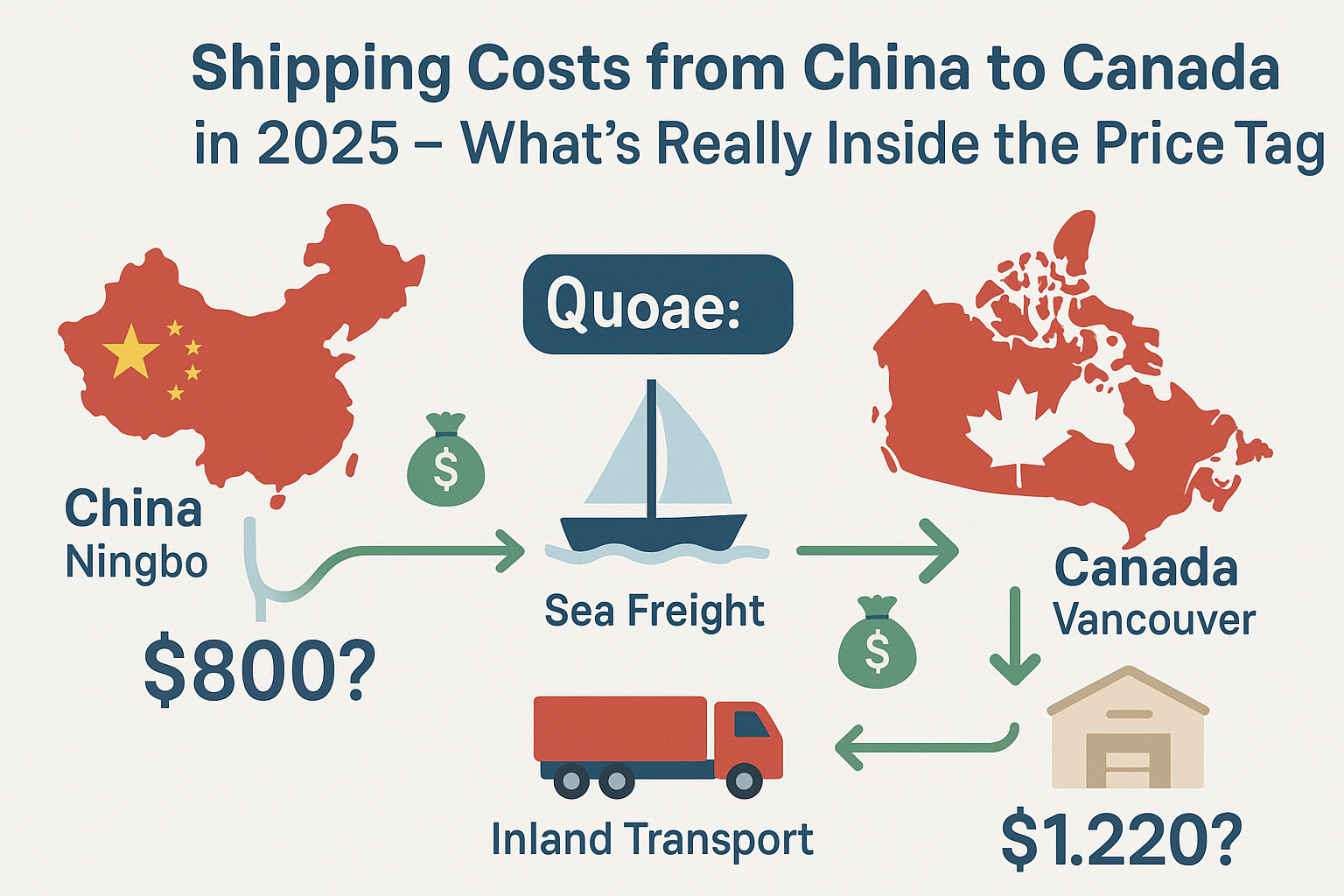Why Canadian Importers Are Rewriting the Playbook in 2025
“$800 for a full container? That’s a steal!”
That’s what many Canadian importers think—until the invoice arrives. What starts as a simple quote from Shenzhen to Vancouver often snowballs into a multi-line surprise: handling fees, inland delivery, GST, customs clearance, and port charges you didn’t see coming.
In 2025, container shipping from China to Canada isn’t just about getting goods across the ocean—it’s about decoding what’s really inside that quote. Because unless you’ve factored in the full landed cost, you’re not actually comparing apples to apples.
That’s why we created this guide: to help you understand what impacts pricing, how FCL and LCL strategies play out across Canadian ports, and how to avoid the cost traps others miss.
Shipping Containers to Canada: What’s Really Inside the Quote?
Shipping to Vancouver isn’t the same as Toronto, and LCL from Qingdao isn’t priced like FCL from Ningbo. But the real issue? Most quotes don’t spell that out.
Before diving deeper, it’s important to understand what’s actually included in a shipment. That means looking beyond just the freight number and breaking down all the components of Shipping Containers moving from China to Canada—freight, duties, documentation, delivery, and more. This guide focuses specifically on container shipping routes, methods, and fees relevant to Canadian-bound cargo, helping importers decode every step.
Core Cost Drivers in 2025:
1. Port Pair & Routing Impact
Shanghai → Vancouver is cheaper but may incur rail transfer costs to Toronto. Qingdao → Halifax could reduce congestion but stretch timelines.
2. Full Container Load (FCL) vs Less-than-Container (LCL)
FCL is cost-efficient if you’ve got volume. LCL gives flexibility but comes with hidden fees.
3. Inland Delivery in Canada
Toronto, Montreal, and Calgary all require rail or trucking from the west coast. This leg adds CAD $300–$800 depending on timing and load.
4. CBSA, GST, and Brokerage Fees
Canada Border Services Agency (CBSA) rules require precise declarations. Some importers forget to budget for GST, especially under FOB terms.
FCL vs LCL — Which Strategy Fits Canadian Logistics?
FCL – Ideal for Consistency and Control
For shipments over 15–18 CBM, especially to Amazon Canada or large 3PLs.
Pros:
- Lower cost per cubic meter
- Shorter customs clearance at Canadian ports
- Direct delivery to Toronto/Montreal via intermodal rail
Cons:
- Higher upfront cost
- Delays if volume under-utilized
LCL – Flexible But Riskier
Great for smaller shipments (<10 CBM), product testing, or seasonal restocks.
Pros:
- Pay only for used space
- Easier to trial new SKUs
Cons:
- Higher per-unit cost
- More touchpoints → greater risk of delay or damage
Canadian Insight: In Vancouver, LCL clearance can take 1–3 extra days during peak congestion.

What Canadian Importers Should Watch in Container Shipping Quotes
Even with the right container type, what’s not in your quote can cost you more.
Must-Have Items in a Transparent Canadian Freight Quote:
- Export documentation from China
- Ocean freight to major Canadian ports (Vancouver/Halifax)
- CBSA import clearance
- GST / PST estimates (especially for Ontario, BC)
- Final-mile delivery (rail or truck)
Red Flags:
- “To be determined” fees (esp. inland delivery)
- No mention of GST or HS code classification
- No clarity on who pays customs broker
Pro Tip: Ask for DDP pricing to eliminate guesswork and improve customs predictability.
When Air Freight to Canada Actually Makes Sense
Not every shipment should float across the Pacific. Some need speed.
Air or Express Is Smarter When:
- Launching high-margin SKUs in peak retail season
- Dealing with SKUs under 3 CBM
- Shipping electronics, accessories, or urgent restocks
Canada-Specific Tip: Air freight to Toronto Pearson (YYZ) can arrive in under 5 days with customs pre-clearance. Useful for tight Amazon Canada windows.
FOB Isn’t Free—What Canadians Misunderstand About FOB Shipping
FOB Shipping is common in global trade—but it hides risks.
What FOB Means:
Your supplier gets goods to the port. You handle everything from there.
But in the Canada–China lane, it means:
- No control over pre-carriage or documentation
- Missed GST or CBSA broker responsibilities
- Surprise charges post-shipment
When FOB Works:
- You have a strong Canadian broker
- You’ve clarified origin charges with your supplier
- You’ve done this route multiple times
For most SMBs, consider DDP or All-In options until you scale.

Choose a Canadian-Focused Freight Forwarder
You don’t just need a forwarder. You need one who knows Canada’s quirks.
Look For:
- In-house customs clearance (no outsourcing delays)
- Familiarity with Toronto/Montreal rail handoffs
- GST/PST documentation support
- Transparent breakdown of Canadian inland fees
Gorto Freight, for example, offers direct coordination from China to Toronto with door-to-door service and all charges visible upfront.
Should You Consolidate Small Shipments in 2025?
Yes—especially if:
- You source from multiple Chinese factories
- Your shipment is 10–14 CBM (borderline FCL)
- You need smoother CBSA clearance
How It Works:
Your forwarder consolidates at origin → combines into 1 FCL → ships to Canada → clears as one entry → delivers to your 3PL.
Saves You:
- 10–20% on total freight
- Multiple customs entries
- Repeated inland trucking
What to Know About Canadian Customs Delays in 2025
Even with a good quote and the right container, a customs delay can derail your whole delivery timeline.
What’s Causing Delays?
- Increased inspections under CBSA’s e-commerce audit programs
- Paperwork errors, especially with HS codes or GST declarations
- Inconsistent declarations from suppliers unfamiliar with Canada’s import process
How to Avoid Them:
- Work with a forwarder that handles customs in-house, not through a 3rd party
- Ask for pre-clearance where possible, especially on air shipments
- Double-check documentation against your purchase orders and packing lists
Tip: If you’re importing electronics or products with batteries, ensure all required certifications are submitted with your B3 entry form to avoid costly holds.
Bonus Insight: Don’t Ignore Container Type When Shipping to Eastern Canada
While most China–Canada freight routes flow through Vancouver, importers targeting eastern cities like Toronto, Ottawa, or Montreal often face longer delays or higher last-mile costs if routing isn’t optimized.
West Coast Route:
- Ships land in Vancouver
- Goods transferred by intermodal rail
- Lower ocean cost but longer total transit time
East Coast Route (e.g., Halifax):
- Higher base freight
- Faster delivery to Toronto via truck
- Less congestion during peak season
Pro Tip: Ask your forwarder to simulate both routes with total landed cost, including rail/trucking. In peak Q4 season, East Coast ports can actually be more predictable.
Final Takeaway — Predictability Trumps Cheap Quotes
Canadian importers in 2025 are no longer chasing lowball container rates. They’re:
- Asking for full landed cost estimates
- Choosing transparent forwarders
- Factoring in CBSA, GST, and last-mile delivery
- Planning ahead for peak seasons
Because the cheapest quote on paper isn’t what you pay. And what you pay impacts your bottom line.
And here’s the bottom line: Predictable freight beats cheap freight—every time.

